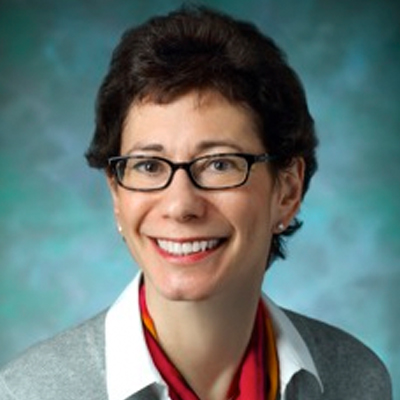Treating Untreatable Cancers
Our cells have a remarkable toolkit of macromolecules that harness the information encoded in our genes and defend our genomes from damage. Intricate patterns of chemical modifications decorate different regions of our chromosomes and dictate whether genes are turned on and off, or whether a break in the chromosome is repaired. Termed the “histone code,” these modifications are attached to the histone proteins that package our chromosomes and range in size from small chemical groups to modifications as large as the protein, ubiquitin. The enzymes that deposit and remove histone modifications thus play a central role in regulating gene expression, as well in marshalling the cell’s response to chromosome damage. Dr. Cynthia Wolberger, of the Johns Hopkins University School of Medicine, uses x-rays to determine the three-dimensional structure of macromolecular complexes that attach and remove histone modifications. By understanding the inner workings of specialized enzyme complexes that can select the right target and attach or remove the right modification from the right site, Dr. Wolberger is able to unravel the cascade of biochemical events that result in an increase or decrease in gene expression or repair of DNA damage. Dr. Wolberger and her team hope to use their molecular insights to establish new avenues to developing drugs that target specific biochemical pathways that are misregulated in cancer.
Dr. Wolberger’s research lays the groundwork for discovering new drugs that can treat cancers that are resistant to currently available chemotherapeutic agents. In fact, her studies of enzyme complexes involved in attaching and removing modifications such as ubiquitin from chromosomes are providing new molecular details on “Achilles heels” in these complexes that can be exploited with new drug therapies. Dr. Wolberger employs cutting-edge chemical techniques to make designer proteins containing the necessary chemical modification, then uses a multidisciplinary approach that combines atomic-resolution information from x-ray crystallography with enzymology, cell-based assays, and a variety of biophysical techniques to determine the mechanisms by which protein modifications are attached, removed and recognized.
Current research includes:
-
Gene regulation: A critical step in turning genes on is the removal of ubiquitin from the histones that package DNA. Dr. Wolberger and her team are studying the large enzyme complex that removes this modification, and which is misregulated in cancers that are resistant to treatment.
-
DNA Damage Response: Chains of ubiquitin proteins are attached to sites of DNA damage and play a critical role in recruiting DNA repair enzymes. Dr. Wolberger is interested in the enzymes that specifically assemble and disassemble ubiquitin signals at damage sites, as well as the proteins that recognize different types of ubiquitin chains as distinct signals.
-
BRCA1: The BRCA1 complex is mutated in many breast cancers and therefore is an important gene to study in order to better identify ways to create therapeutics for patients with cancer. Dr. Wolberger’s studies of hybrid SUMO-ubiquitin chains, including their role in recruiting the BRCA1 complex, are offering new hope to patients.
Bio
Since high school, Dr. Wolberger was fascinated by how things occur in the cell and how all the moving parts fit together to carry out the myriad processes that are the basis of life. While she has studied a variety of different biological phenomenon a common thread has been the study of how genes are turned on and off. Since this is such a central process in the cell, understanding how our genomic information is accessed in response to different signals is really at the heart of biology!
Dr. Wolberger is a coauthor of the undergraduate textbook, “Molecular Biology: Principles of Genome Function” (Oxford University Press), now in its second edition.
In her free time, Dr. Wolberger enjoys swimming, gourmet cooking, visiting museums, and traveling. She also is fond of learning new languages and as a result is fluent in both Hebrew and German. A fun fact most people don’t know about Dr. Wolberger is that as a child she was on the show, Candid Camera, where she was filmed winking while at nursery school!
In the News
The Gazette
Chron
News & Information Services - Johns Hopkins


